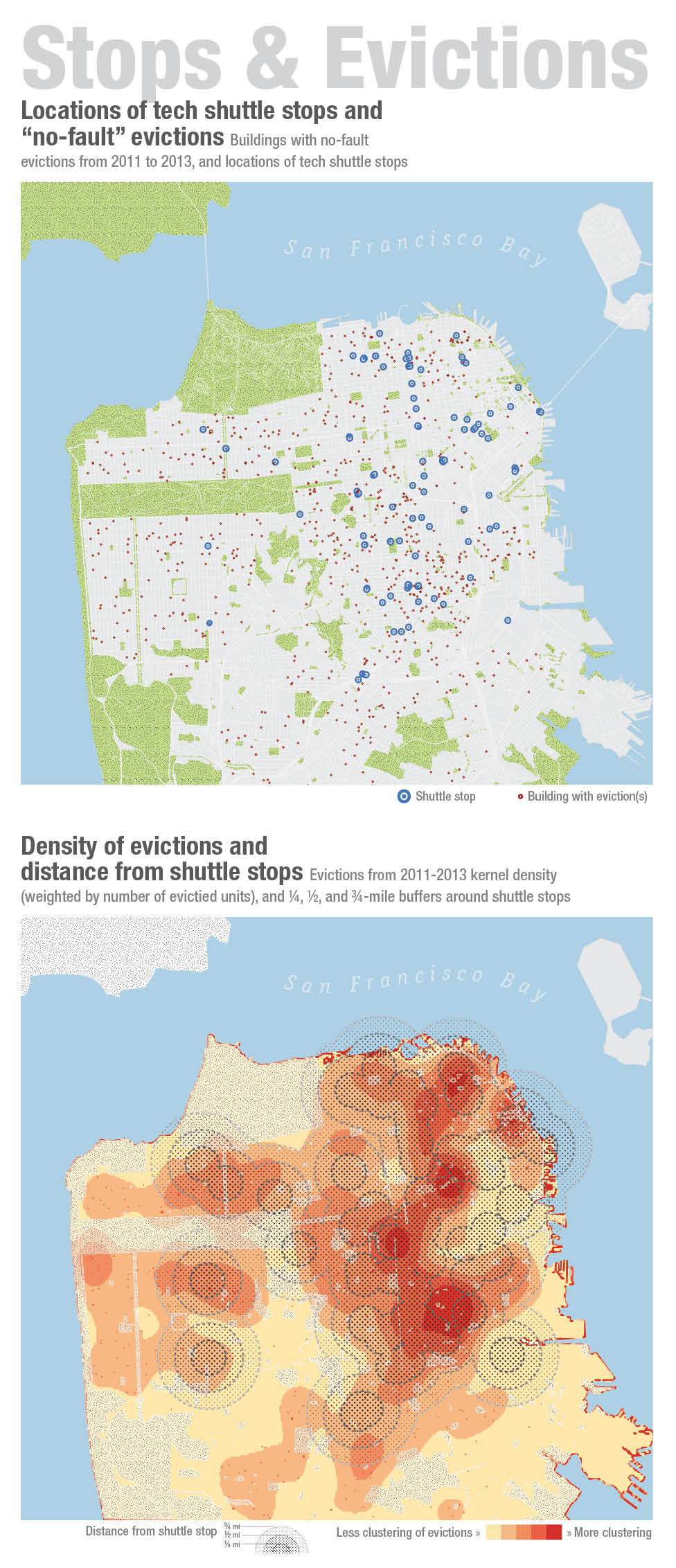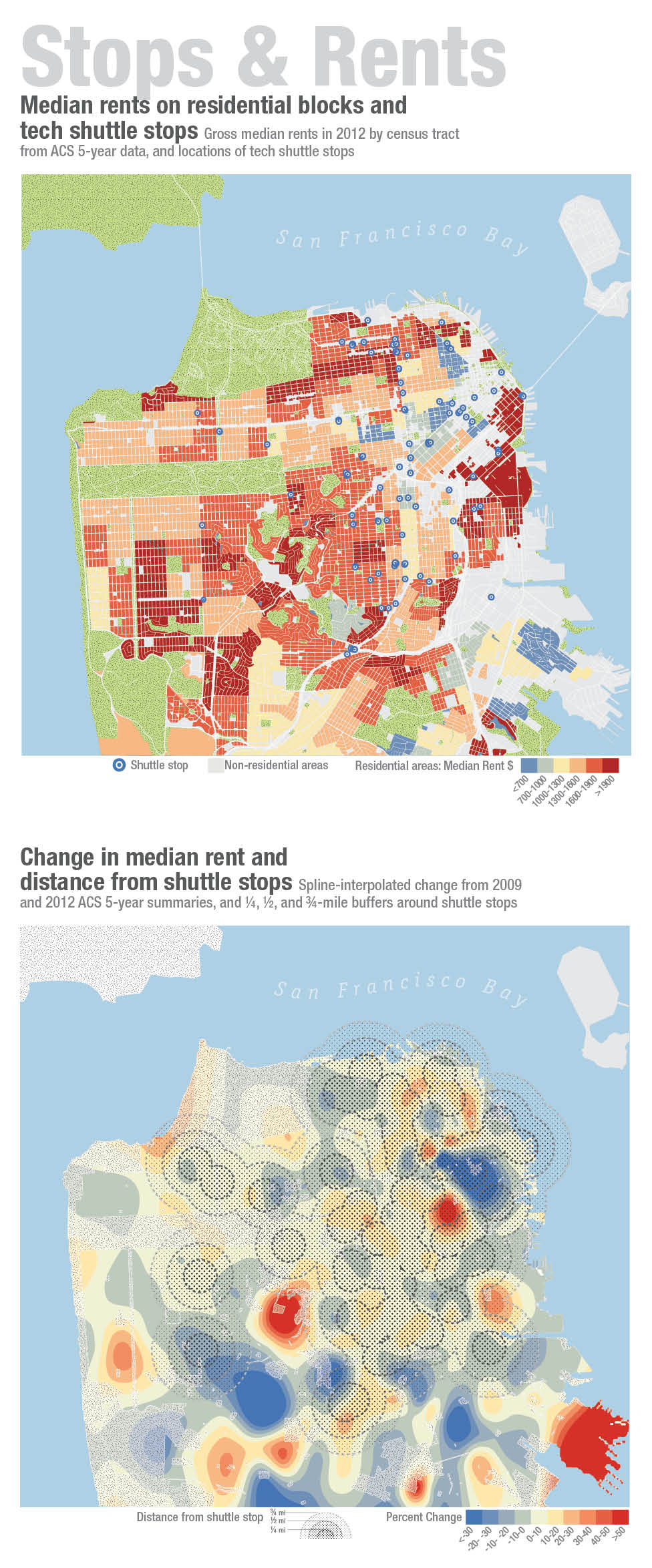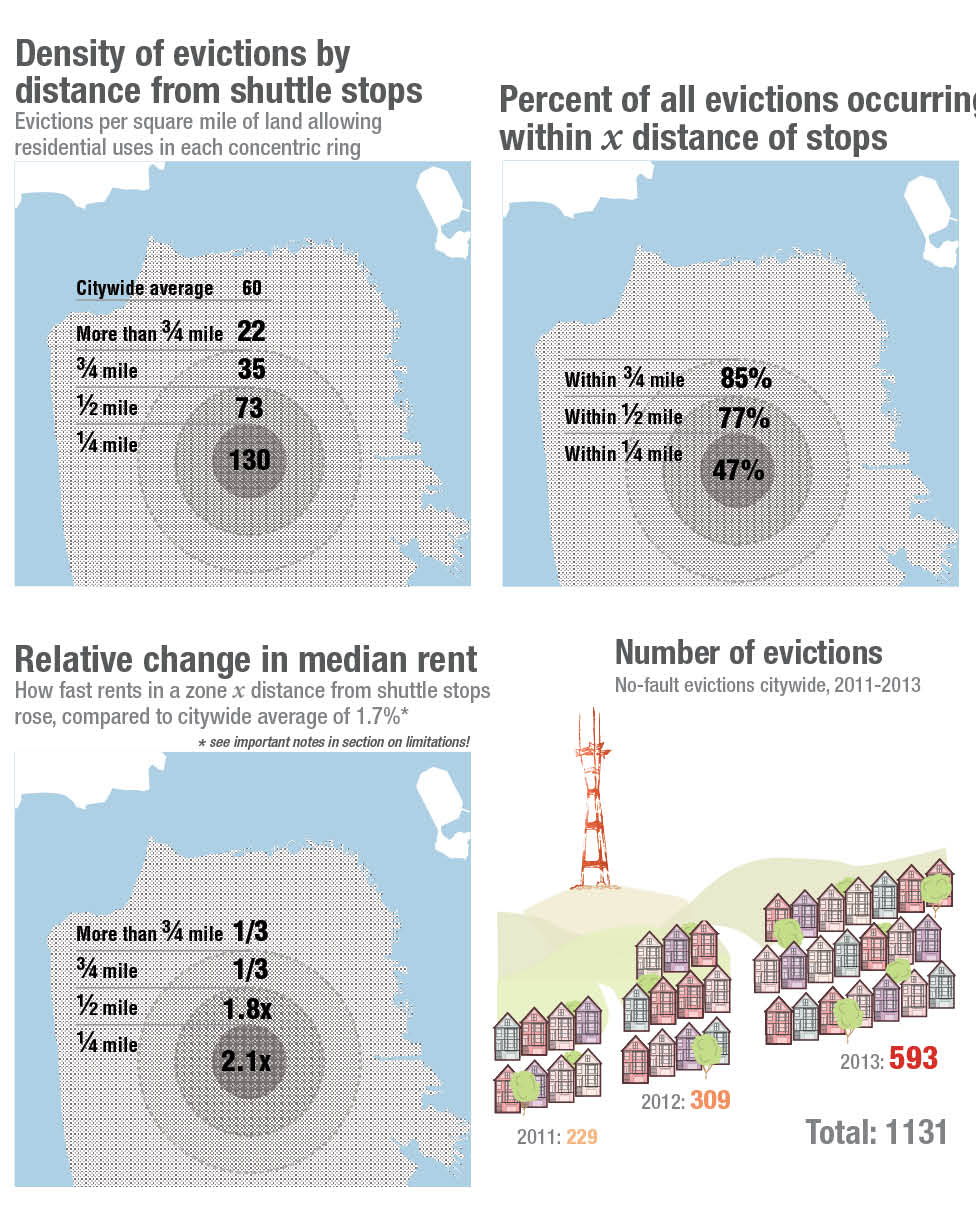CONTEXT
San Francisco is in the midst of a housing and rental affordability crisis. From 2009 to 2012, median rent rose for the city by 5% (adjusted for inflation). Many ongoing factors have contributed to San Francisco’s current affordability crisis, including the growing high tech economy in Silicon Valley and San Francisco, the lack of new affordable and diverse housing stock built in the Bay Area, and the presence of tech industry shuttle buses. Rather than addressing the contentious debate if the tech industry is the main responsible actor for the ongoing displacement and affordability issues taking place in San Francisco, this project uses GIS to discover if the rates of displacement and unaffordability have a correlation with the proximity of tech shuttle stops.
San Francisco is in the midst of a housing and rental affordability crisis. From 2009 to 2012, median rent rose for the city by 5% (adjusted for inflation). Many ongoing factors have contributed to San Francisco’s current affordability crisis, including the growing high tech economy in Silicon Valley and San Francisco, the lack of new affordable and diverse housing stock built in the Bay Area, and the presence of tech industry shuttle buses. Rather than addressing the contentious debate if the tech industry is the main responsible actor for the ongoing displacement and affordability issues taking place in San Francisco, this project uses GIS to discover if the rates of displacement and unaffordability have a correlation with the proximity of tech shuttle stops.
PROBLEM
Do tech shuttle stops lead to higher rates of displacement (evictions) and unaffordability in the San Francisco rental market, as compared to the city as a whole? In other words, does the proximity of shuttle stops increase the likelihood of displacement and unaffordability in the rental market?
Do tech shuttle stops lead to higher rates of displacement (evictions) and unaffordability in the San Francisco rental market, as compared to the city as a whole? In other words, does the proximity of shuttle stops increase the likelihood of displacement and unaffordability in the rental market?
METHODOLOGY & DATA SOURCES
In collaboration with the Anti-Eviction Mapping Project and the San Francisco Rent Board, we gathered data on evictions in San Francisco (no-fault evictions, Ellis Act, and demolitions), and tech shuttle stop locations for the last three years (2011-2013). Additionally, we used data from the American Community Survey to contextualize the current rental market in the city, looking at Median Gross Rent from 2009-2012 and the percent change over that time.
In collaboration with the Anti-Eviction Mapping Project and the San Francisco Rent Board, we gathered data on evictions in San Francisco (no-fault evictions, Ellis Act, and demolitions), and tech shuttle stop locations for the last three years (2011-2013). Additionally, we used data from the American Community Survey to contextualize the current rental market in the city, looking at Median Gross Rent from 2009-2012 and the percent change over that time.
Identify Problem » Data Mining » Geocode » Interpolation » Spatial Analysis » Conclusions
After we identified the appropriate factors (median rent, evictions, locations of tech shuttle stops), we geocoded to identify the proper areas of analysis. Upon geocoding all of the evictions and tech shuttle stop locations, we further analyzed how many evictions have happened in total, as well as within quarter-mile, half-mile, and three-quarter-mile areas from the tech shuttle stops, including only zoning district areas which allow residential uses. Finally, to understand the overall impact of evictions and unaffordability, we analyzed the density of evictions and interpolated the change in median rent to identify the areas with the greatest changes over the last three years.



FINDINGS
Our findings demonstrate that the location and proximity of tech shuttle stops correlate with (1) a higher number of rental evictions and (2) greater unaffordability in the rental market, as compared to the San Francisco as a whole.
Our findings demonstrate that the location and proximity of tech shuttle stops correlate with (1) a higher number of rental evictions and (2) greater unaffordability in the rental market, as compared to the San Francisco as a whole.
Analyzing quarter-mile, half-mile, and three-quarter-mile areas around shuttle stops, a clear pattern emerges, showing stronger increases in median rent and density of evictions with greater proximity to shuttle stops. Closest to stops, these trends peak, showing rates more than double those of the citywide averages.
For example, within a quarter mile of shuttle stops, our analysis showed the average median rent increase by 3.6% from 2009 to 2012, compared with a 1.7% increase for the city as a whole. Similarly, within a quarter-mile of shuttle stops, the density of all evictions occurring between 2011 and 2013 was 130 per square mile, compared to an average of 60 evictions per square mile for the city as a whole.
LIMITATIONS
Although this analysis points to a strong correlation between tech shuttle stops and a higher rate of displacement and unaffordability in San Francisco’s rental market, it is dependant upon data that contain some inherent limitations. A notable case is the use of 5-year estimates of gross median rents from the American Community Survey. This data was based on a census tracts, and interpolating that data to more smoothly cover the City created other important issues: spatial analysis of the interpolated data showed a 1.7% average citywide rate of increases to rent costs, while ACS data for the City as a whole reflects a more accurate 5% increase. While we are confident the rate of relative change in rents is generally dependable, the actual rate of change is likely somewhat different, possibly higher overall.
Although this analysis points to a strong correlation between tech shuttle stops and a higher rate of displacement and unaffordability in San Francisco’s rental market, it is dependant upon data that contain some inherent limitations. A notable case is the use of 5-year estimates of gross median rents from the American Community Survey. This data was based on a census tracts, and interpolating that data to more smoothly cover the City created other important issues: spatial analysis of the interpolated data showed a 1.7% average citywide rate of increases to rent costs, while ACS data for the City as a whole reflects a more accurate 5% increase. While we are confident the rate of relative change in rents is generally dependable, the actual rate of change is likely somewhat different, possibly higher overall.
Other analyses also encountered limitations; for example, the most recent data available for evictions covers only the period between 2011 and 2013. While efforts were made to include as many major tech shuttle stops as possible, not all are necessarily shown. Additionally, data about when each tech shuttle stop became active and used is not available, although sources like news articles point to such
shuttle programs becoming active as early as 2004 for companies like Google and Yahoo!. This data could help provide a more complete analysis of potential causes and effects.
Finally, many intertwined and complex factors contribute to the overall unaffordability and displacement happening within San Francisco. Although our findings show a higher rate of increase in rent and evictions as proximity to shuttle stop increases, we cannot conclude that shuttle stop location is the only factor that contributes to displacement and unaffordability. Further research and analysis is required, especially with regards to the timing in which the shuttle stops became active, the various reasons for a Ellis Act or demolition eviction, and the overall motivations for why highly-paid workers choose to live in San Francisco’s historically diverse and affordable neighborhoods.
